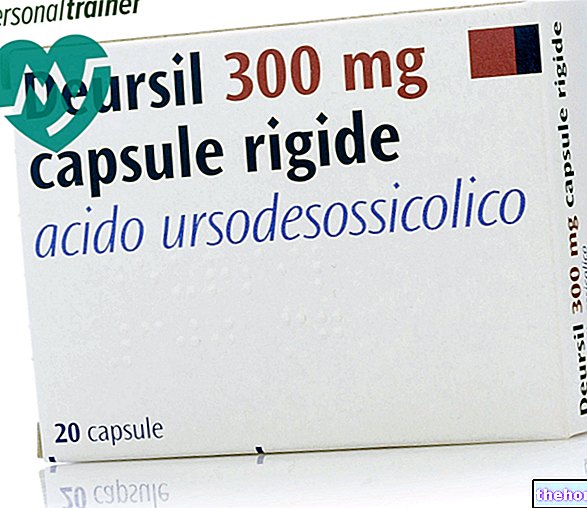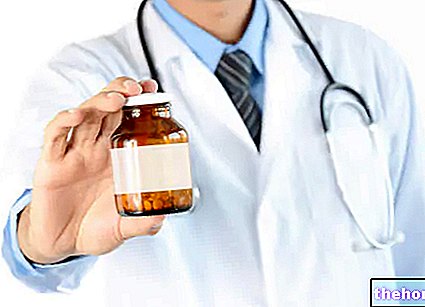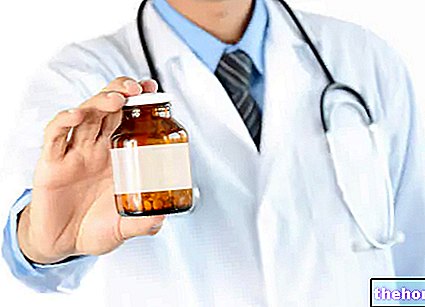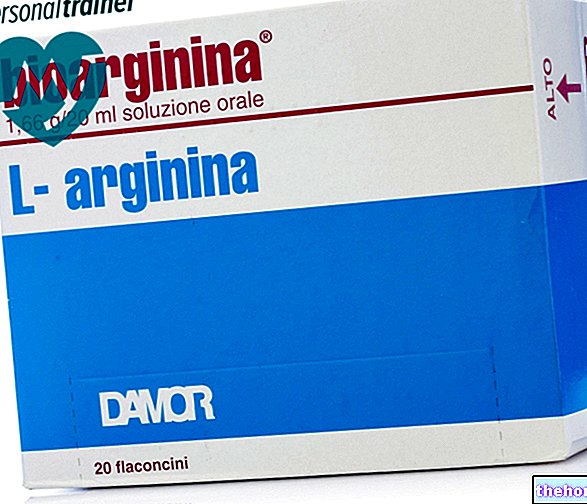Active ingredients: Fusafungine
LOCABIOTAL ® 15 ml
Why is Locabiotal used? What is it for?
On 01/04/2016, the Italian Medicines Agency (Aifa) ordered the immediate withdrawal of the packages present on the Italian medicine market.
The Pharmacovigilance Risk Assessment Committee of the EMA (European Medicines Agency) has in fact concluded that the benefits of fusafungine do not outweigh its risks, in particular due to the possible occurrence of severe allergic reactions.
Pharmacotherapeutic group
Prepare for the pharyngeal cavity
Therapeutic indications
Local antibacterial and anti-inflammatory treatment of upper respiratory tract diseases: sinusitis, rhinitis, nasopharyngitis, angina, laryngitis, tracheitis.
Contraindications When Locabiotal should not be used
Hypersensitivity to the active substance or to any of the excipients.
Children under the age of 30 months (possible laryngospasm).
Precautions for use What you need to know before taking Locabiotal
Use Locabiotal with caution if you have a predisposition to allergies or suffer from asthma, or if you have already had an asthma attack or a feeling of shortness of breath following a tightening of the airways (bronchospasm).
Prolonged use can favor the appearance of superinfections.
In the absence of improvement in signs and symptoms after one week of treatment, alternative therapy should be considered.
Propylene glycol can cause skin irritation.
This medicine contains small amounts of ethanol (alcohol), less than 100 mg per dose.
Interactions Which drugs or foods may change the effect of Locabiotal
Tell your doctor or pharmacist if you have recently taken any other medicines, even those without a prescription.
No interactions have been reported during local treatments with fusafungine, particularly when combined with systemic antibiotics.
Warnings It is important to know that:
Pregnancy and breastfeeding
Ask your doctor or pharmacist for advice before taking any medicine.
The use of Locabiotal is not recommended during pregnancy or breastfeeding.
Effects on ability to drive and use machines
Locabiotal has no or negligible influence on your ability to drive or use machines
Dose, Method and Time of Administration How to use Locabiotal: Posology
Attack treatment: 2 sprays by mouth and / or 2 sprays in each nostril every 4 hours for 4 days.
Maintenance treatment: 1 spray by mouth and / or 1 spray in each nostril every 4 hours.
Before using the bottle for the first time, prime the high-precision pump (see instructions for use).
The usual treatment should not exceed 10 days; after this period, the methods of administration should be re-examined.
How to use
The bottle should be held upright, upright between the thumb and forefinger, with the inhaler pointing upwards.
For the first use, perform 5 vacuum sprays to prime the high-precision pump.
Use of the oral inhaler (white): to administer the product, introduce the oral inhaler into the mouth closing the lips around it, then press firmly for a long time.
Using the nasal inhaler (yellow): insert the end of the nasal inhaler into one nostril and then press firmly for a long time.
Overdose What to do if you have taken too much Locabiotal
If you accidentally take an overdose of Locabiotal, notify your doctor immediately or go to the nearest hospital.
There is limited experience with overdose with fusafungine. Circulatory disturbances, numbness of the mouth, dizziness, aggravation of sore throat and chemical burn of the throat have been reported.
Management of overdose should include treatment of clinical symptoms and routine monitoring.
IF YOU ARE IN ANY DOUBT ABOUT USING LOCABIOTAL, CONTACT YOUR DOCTOR OR PHARMACIST.
Side Effects What are the side effects of Locabiotal
Like all medicines, Locabiotal can cause side effects, although not everybody gets them. The frequency of possible adverse reactions listed below is described using the following convention:
- very common (affects more than 1 in 10 patients)
- common (affects 1 to 10 users in 100)
- uncommon (affects 1 to 10 users in 1,000)
- rare (affects 1 to 10 users in 10,000)
- very rare (affects less than 1 user in 10,000)
- not known (frequency cannot be estimated from the available data).
Allergic reactions are very rare but can occur, particularly in patients with a predisposition to allergies. The most commonly reported side effects are local reactions at the administration site.
Side effects include:
General disorders and administration site conditions
Very common: sneezing, dysgeusia, conjunctival congestion.
Common: dry nose, dry throat, throat irritation, cough, nausea.
Not known: vomiting.
These side effects generally do not require discontinuation of treatment.
Disorders of the immune system
Very rare: anaphylactic shock (severe allergic reaction).
Respiratory, thoracic and mediastinal disorders
Very rare: asthma, bronchospasm (tightness in the chest, wheezing and shortness of breath), dyspnoea (difficulty breathing), laryngeal spasm, larynx edema.
Skin and subcutaneous tissue disorders
Very rare: rash, itching, hives, Quincke's edema (rapid swelling of tissues such as the face, lips, mouth, tongue or throat which may cause difficulty in breathing).
In case of allergic reactions, fusafungine must not be re-administered.
Given the risk of anaphylactic shock, in case of respiratory, laryngeal or skin symptoms (pruritus, generalized erythema), an intramuscular injection of adrenaline is urgently needed. The usual dose of adrenaline is 0.01 mg / kg intramuscularly. The dose can be repeated after 15 to 20 minutes if necessary.
Compliance with the instructions contained in the package leaflet reduces the risk of undesirable effects.
If any of the side effects gets serious, or if you notice any side effects not listed in this leaflet, please inform your doctor or pharmacist.
Expiry and Retention
Expiry: see the expiry date indicated on the package.
Warning: do not use the medicine after the expiry date indicated on the package.
The expiry date indicated refers to the product in intact packaging, correctly stored.
Medicines should not be disposed of via wastewater or household waste. Ask your pharmacist how to throw away medicines you no longer use. This will help protect the environment.
KEEP THE MEDICINAL PRODUCT OUT OF THE REACH AND SIGHT OF CHILDREN.
Composition
Each bottle of 15 ml contains: Active ingredient: fusafungine 50 mg. Excipients: aromatic composition 14869 [compound essence 10115 (2/3) and eucalyptol (1/3)]; Ethanol; Saccharin; Isopropyl myristate.
Pharmaceutical form and content
Oral and nasal solution.
15 ml pump bottle.
Each spray delivers 0.05 ml equal to 0.5 mg of fusafungine.
Source Package Leaflet: AIFA (Italian Medicines Agency). Content published in January 2016. The information present may not be up-to-date.
To have access to the most up-to-date version, it is advisable to access the AIFA (Italian Medicines Agency) website. Disclaimer and useful information.
01.0 NAME OF THE MEDICINAL PRODUCT
LOCABIOTAL
02.0 QUALITATIVE AND QUANTITATIVE COMPOSITION
p. 100 ml p. 5 ml
Active principle: fusafungine * (D.C.I.) 1000 mg 50 mg
* Antibiotic extracted from Fusarium lateritium WR, strain 437
For the full list of excipients, see section 6.1.
03.0 PHARMACEUTICAL FORM
Oral and nasal solution.
15 ml pump bottle with high precision dispenser.
Each spray delivers 0.05 ml equal to 0.5 mg of fusafungine.
04.0 CLINICAL INFORMATION
04.1 Therapeutic indications
Local antibacterial and anti-inflammatory treatment of upper respiratory tract diseases: sinusitis, rhinitis, nasopharyngitis, angina, laryngitis, tracheitis.
N.B .: In the presence of clinical signs of general bacterial infection, the association with a systemic antibiotic therapy is recommended.
04.2 Posology and method of administration
Attack treatment: 2 sprays by mouth and / or 2 sprays in each nostril every 4 hours for 4 days.
Maintenance treatment: 1 spray by mouth and / or 1 spray in each nostril every 4 hours.
Before using the bottle for the first time, prime the high-precision pump (see instructions for use).
The usual treatment should not exceed 10 days; after this period, the methods of administration should be re-examined.
04.3 Contraindications
Hypersensitivity to the active substance or to any of the excipients.
Children under the age of 30 months (possible laryngospasm).
04.4 Special warnings and appropriate precautions for use
Caution should be exercised in patients with allergy predisposition and bronchospasm (see section 4.8).
Prolonged use can favor the appearance of superinfections.
In the absence of improvement in signs and symptoms after one week of treatment, alternative therapy should be considered.
Propylene glycol can cause skin irritation.
This medicinal product contains small amounts of ethanol (alcohol), less than 100 mg per dose.
04.5 Interactions with other medicinal products and other forms of interaction
No interactions have been reported during local treatments with fusafungine, particularly when combined with systemic antibiotics.
No interaction studies have been performed.
04.6 Pregnancy and lactation
Pregnancy
No clinical data on exposed pregnancies are available. Animal studies do not indicate direct or indirect harmful effects with respect to pregnancy, embryo / fetal development, parturition or postnatal development. It is necessary to use caution when the drug is prescribed to pregnant women.
Feeding time
It is not known whether fusafungine is excreted in human milk. Animal studies on the excretion of fusafungine in milk have not been conducted. A consideration must be made whether to discontinue breast-feeding or to discontinue therapy with Locabiotal taking into account the benefit of breast-feeding for the child and the benefit of therapy for the woman.
Fertility
Reproductive toxicity studies showed no effects on the fertility of male and female rats (see section 5.3).
04.7 Effects on ability to drive and use machines
Fusafungine has no or negligible influence on the ability to drive or use machines.
04.8 Undesirable effects
The following side effects have been observed during treatment with fusafungine and classified with the following frequency:
very common (≥1 / 10); common (≥1 / 100,
Allergic reactions are very rare but can occur, particularly in patients with a predisposition to allergies. The most commonly reported side effects are local reactions at the administration site.
General disorders and administration site conditions
Very common: sneezing, dysgeusia, conjunctival congestion.
Common: dry nose, dry throat, throat irritation, cough, nausea.
Not known: vomiting.
These side effects generally do not require discontinuation of treatment.
Disorders of the immune system
Very rare: anaphylactic shock.
Respiratory, thoracic and mediastinal disorders
Very rare: asthma, bronchospasm, dyspnoea, laryngeal spasm, larynx edema.
Skin and subcutaneous tissue disorders
Very rare: rash, pruritus, urticaria, Quincke's edema.
In case of allergic reactions, fusafungine must not be re-administered.
Given the risk of anaphylactic shock, in case of respiratory, laryngeal or skin symptoms (pruritus, generalized erythema), an intramuscular injection of adrenaline is urgently needed. The usual dose of adrenaline is 0.01 mg / kg intramuscularly. The dose can be repeated after 15 to 20 minutes if necessary.
04.9 Overdose
There is limited experience with overdose with fusafungine. Circulatory disturbances, numbness of the mouth, dizziness, aggravation of sore throat and chemical burn of the throat have been reported.
Management of overdose should include treatment of clinical symptoms and routine monitoring.
05.0 PHARMACOLOGICAL PROPERTIES
05.1 Pharmacodynamic properties
Pharmacotherapeutic group: preparations for the pharyngeal cavity, ATC code: R02AB03
Antibacterial: fusafungine is a local antibiotic which, due to its antibacterial activity, is active on: group A streptococci, pneumococci, staphylococci, some strains of Neisseria, some anaerobic organisms, Candida albicans and Mycoplasma pneumoniae.
Anti-inflammatory: Fusafungine has anti-inflammatory properties.
05.2 Pharmacokinetic properties
The deposition of the active ingredient and its distribution in the upper respiratory tract were confirmed by gamma-scintigraphy with fusafungine labeled with Technetium-99. In humans, fusafungine is not detectable in plasma following inhalation administration.
05.3 Preclinical safety data
Fusafungine at doses much higher than those used in the clinic, showed neither toxicity nor teratogenic or mutagenic action.
Repeated oral administration studies of fusafungine in rats showed no effects on reproductive organs after macroscopic and histological evaluation.
06.0 PHARMACEUTICAL INFORMATION
06.1 Excipients
Aromatic composition 14869 [compound essence 10115 (2/3) and eucalyptol (1/3)], ethanol, isopropyl myristate, saccharin.
06.2 Incompatibility
None.
06.3 Period of validity
24 months.
06.4 Special precautions for storage
Store at room temperature.
06.5 Nature of the immediate packaging and contents of the package
The plasticized glass measuring bottle containing 5 ml of solution is equipped with a high-precision pump.
Each spray delivers 0.05ml, or 0.5mg, of fusafungine. One dispenser bottle delivers approximately 100 sprays (per 5 ml).
The dispenser bottle is equipped with two inhalers:
- nasal inhaler (yellow)
- oral inhaler (white)
06.6 Instructions for use and handling
The bottle should be held upright, upright between the thumb and forefinger, with the inhaler pointing upwards.
For the first use, perform 5 vacuum sprays to prime the high-precision pump.
Using the oral inhaler (white)
To administer the product, introduce the oral inhaler into the mouth closing the lips around it, then press firmly for a long time.
Using the nasal inhaler (yellow)
Insert the tip of the nasal inhaler into one nostril and then press firmly for a long time.
07.0 MARKETING AUTHORIZATION HOLDER
Les Laboratoires Servier
92200 Neuilly-sur-Seine (France)
08.0 MARKETING AUTHORIZATION NUMBER
A.I.C. n. 021939020
09.0 DATE OF FIRST AUTHORIZATION OR RENEWAL OF THE AUTHORIZATION
1/6/2010
10.0 DATE OF REVISION OF THE TEXT
December 2011




























